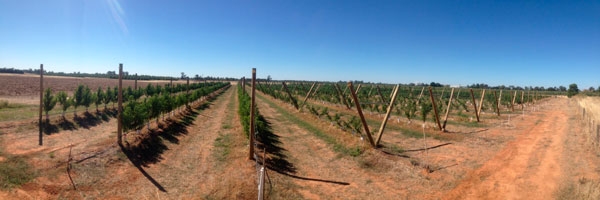The Profitable Stonefruit Systems Project aims to generate knowledge about how to consistently produce fruit of optimum size and quality in commercial orchards.
This will be done by studying the interaction between rootstock, tree training system, crop load and irrigation management.
As part of the Project, a new experimental orchard has been established at Tatura, Victoria.
A particular emphasis of the study is to improve fruit sweetness, measured as total soluble solids (brix). The project aims to develop grower management strategies that are readily adoptable by the Australian stonefruit industry to enhance its competitiveness and productivity.
Table 1 summarises details of cultivar, treatments, tree training, plant density and establishment dates of field experiments and demonstration blocks on peach, nectarine, apricot and plum at the Stonefruit Field Laboratory, Tatura.
The site occupies 3.4 ha and has about 5800 trees. Trees have been planted progressively since 2013 as plant material (scion/rootstock) became available from local nurseries.
All tree rows are oriented north–south. Each experiment is planted with export varieties and a range of early, mid and late-season crops.
Tree density ranges from 926 to 2222 trees/ha.
Figure 1 illustrates two distinctive tree canopy training systems: vertical and Tatura Trellis (see Table 1: Experiments 2a–2d) at the Stonefruit Field Laboratory.
Figure 2 shows examples of tree configurations in demonstration blocks. The 2-dimensional tree structure configurations provide the platform for mechanical pruning and/or harvesting.
Site description & orchard management
Soil preparation, nutrition, and pest, disease and weed management has been the same across all trees and centered on best-practice to maintain and encourage tree growth and development.
The soil type is a red-brown earth (known locally as Shepparton fine sandy loam).
The region has a temperate climate with average annual rainfall of approximately 480 mm. Annual average evaporative demand, known as reference crop evapotranspiration (ETo) is about 1190 mm.
Irrigation and fertigation management
Irrigation sub-mains installed to each experiment provide the ability to control water (and nutrient) inputs to meet the specific requirements of species/cultivar and experimental treatment design.
All trees are irrigated using dripper tape positioned along the tree line.
Emitter (pressure compensated) spacing is 0.5 m with a flow rate of 1.6 L/h. Water flow meters are used to monitor irrigation inputs.
Irrigation water is applied daily.
(Continued next issue)
For more information and images, see Tree Fruit September 2015






















